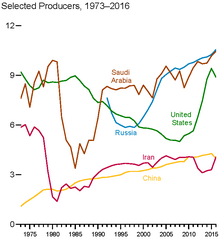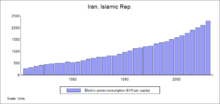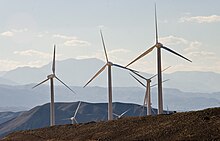Energy in Iran

Energy resources in Iran consist of the second largest oil reserves and the second largest natural gas reserves in the world. Iran is in a constant battle to use its energy resources more effectively in the face of subsidization and the need for technological advances in energy exploration and production. Energy wastage in Iran amounts to six or seven billion dollars (2008). The energy consumption in the country is extraordinarily higher than international standards. Iran recycles 28 percent of its used oil and gas whereas the figure for certain countries stands at 60 percent.[1] Iran paid $84 billion in subsidies for oil, gas and electricity in 2008.[2]
Iran is one of the leading members of OPEC (Organization of Petroleum Exporting Countries). According to data from 2006, Iran holds the world’s second largest supply of oil and natural gas reserves, trailing only Saudi Arabia and Russia respectively. Iran received $47 billion dollars in oil export revenues, which accounts for about 50% of state revenues.[3] Natural gas and oil consumption both account for about half of Iran’s domestic energy consumption. With its heavy dependence on oil and gas revenues Iran continues to explore for new sources of natural gas and oil. Recently Iran has focused its energy sector on the exploration of the South Pars offshore natural gas fields in the Persian Gulf.[4]
Iran has become self-sufficient in designing, building and operating dams and power plants and it has won a good number of international bids in competition with foreign firms.[5]
Power generation capacity of Iranian thermal power plants reached 173 terawatt hours in 2007. Accounting for 17.9 percent of power production in the Middle East and African region. Natural gas has been the main energy in Iran in 2007, comprising over 55 percent of energy needs, while oil and electricity accounted for 42 and 2 percent respectively. The region’s energy need will increase by 26.8 percent until 2012.[6]
Oil

Iran has the second largest oil reserves in the world, and the third largest exporter of it. According to 2006 estimates Iran produced about five percent of total global crude oil production. They produced 4.2 million barrels per day (670,000 m3/d) of total liquids and 3.8 million of those barrels were crude oil. Iran plans to invest $100 billion during the next four years in different sections of its oil industry (2009).[8]
Iran possesses abundant fuels from which to generate energy. Since 1913 Iran has been a major oil exporting country. Oil industry output averaged 4 million barrels per day in 2005, compared with the peak output of 6 million barrels per day (950,000 m3/d) reached in 1974. Following the 1979 revolution, however, the government reduced daily oil production in accordance with an oil conservation policy. Further production declines occurred as result of damage to oil facilities during the war with Iraq. In the early 2000s, industry infrastructure was increasingly inefficient because of technological lags. Few exploratory wells were drilled in 2005. Iranian oil was nationalized in 1953 and thus is owned and operated by the National Iranian Oil Company (NIOC).
Iran holds 10% of the world's proved oil reserves and that figures out to be about 136 billion barrels (2.16×1010 m3) of oil reserves. Oil also is found in northern Iran and in the offshore waters of the Persian Gulf. Nevertheless, in 2005 Iran spent US$4 billion dollars on fuel imports, mainly because of contraband and inefficient domestic use that result from subsidies.
There is a growing recognition that prices must rise faster to curb consumption and ease the burden on the public finances. Cheap energy has encouraged wasteful consumption in Iran, and a brisk business in smuggling petrol into Iraq, Turkey, Pakistan and Afghanistan. Demand has also been supported by rapid increases in car production in recent years. In the absence of imports, the car industry has developed strongly (albeit from a low base) with output reaching over 1m vehicles in fiscal year 2006/07 (March 21st-March 20th).[9]
The growth in consumption of domestically produced oil has been modest, owing to refining constraints. By contrast, fuel imports rose to 180,000 barrels/day in January 2005 from 30,000 barrels/day in 2000, and petrol consumption is estimated to have been around 1.8 million barrels/day in 2007 (before rationing), of which about one-third is imported. These imports are proving expensive, costing the government about US$4bn in the first nine months of 2007/08, according to parliamentary sources.[9] Nearly 40% of refined oil consumed by Iran is imported from India.[10]
Iran contains 27 onshore and 13 offshore oil producing fields which are largely concentrated in the southwestern Khuzestan region near the Iraqi border.[4] The Iranian government is heavily reliant on oil revenues and they have heavily subsidized the energy industries which figures out to be about 12% of Iran’s GDP. However, domestic oil consumption has decreased due to the alternative use of natural gas. Economic growth from these resources is uncertain and stunted in Iran due to these subsidies and population growth. Iran has been unable to reach it full production levels due to a combination of sanctions and war which has plagued the region. Iran’s oil fields have a natural decline rate at 8 percent for onshore wells and 10% for offshore fields. The Iranian recovery rate is currently approximately 27 percent which is well below the world average. Iran needs structural improvements made to coincide with their enhanced oil recovery efforts.[4]
Iran is one of the largest gasoline consumers in the world ranking second behind United States in consumption per car.[11]
Natural gas
Iran has the world's second largest reserves of natural gas (15% of the world's total); these are exploited primarily for domestic use. It contains an estimated 974 trillion cubic feet (Tcf) in proven natural gas reserves.[12] In 2005 a large share of Iran’s natural gas reserves were believed to remain untapped. About 62% of these reserves are located in non-associated fields. Iranian production of natural gas is expected to increase over the next few years due to continuing discoveries in the North Pars and South Pars regions.[13]
Domestic consumption has matched production at 3.6 Tcf in the year of 2005. Domestic consumption is expected to go up at about 7% per year for the following decade. The Iranian government has also subsidized natural gas prices along with gasoline prices, and this is expected to sustain this high level of domestic consumption. In lieu of this increasing domestic demand, natural gas exports are expected to decrease in the following years.[14]
Iran has the third largest consumption of natural gas in the world after United States and Russia.[15]
Electricity

Iran’s domestic consumption and production have steadily grown together since 1984 and it is still heavily reliant on traditional thermal energy sources of electricity, with a small fraction being produced by hydroelectric plants.[18] Consumption has steadily risen and it is expected to rise at about 6 percent per year for the following decade. Accordingly, the Iranian energy sector must focus its efforts on meeting this continuing demand. It is estimated that some 18.5 percent of electricity generated in Iran are wasted before it reaches consumers due to technical problems.[19] Iran is among the top ten manufacturers of gas turbines with a capacity of 160 megawatts.[20] Iran has acquired self-sufficiency of over 80 percent in constructing hydraulic turbines and over 90 percent in producing gas turbines. Within the next few years, Iran can join the list of countries that produce power plant technology (2009).[21]
The exploration efforts for sources of power generation are wide and diverse in Iran. Plans are being made to make oil efficient power plants as well as an emphasis on natural gas production in order to meet their growing electricity demand. Nuclear power and hydroelectric power are not focused on for the time being, but they are part of an overall strategy to meet electricity demands. The electricity sector is also heavily subsidized and mostly state owned companies control power distribution, transmission and generation. In order to meet the demands of the electricity sector, however, Iran is beginning to look into private investment.[22] A by-law has been passed allowing the energy ministry to conclude rial or combined rial/foreign-currency contracts for the purchase of electricity from private companies.[9]

By 2004 the addition of new hydroelectric stations and the streamlining of conventional coal- and oil-fired stations increased installed capacity to 33,000 megawatts (MW). Of that amount, about 75 percent was based on natural gas, 18 percent on oil, and 7 percent on hydroelectric power. In 2004 Iran opened its first wind-powered and geothermal plants, and the first solar thermal plant was to come online in 2009. Iran has recoverable coal reserves of nearly 1.9bn short tonnes. The country produces about 1.3m short tonnes of coal annually and consumes about 1.5m short tonnes, making it a small net importer of coal.[9]
Demographic trends and intensified industrialization have caused electric power demand to grow by 8 percent per year. The government’s goal of 53,000 megawatts of installed capacity by 2010 is to be reached by bringing on line new gas-fired plants financed by independent power producers, including those with foreign investment backing, and by adding hydroelectric and nuclear power generating capacity. Iran is not only self-sufficient in power plant construction but has also concluded a number of contracts on implementing projects in neighboring states.[23] A research by the Ministry of Energy indicated that between 15,000-20,000 megawatts of capacity should be added in Iran in the next 20 years.[24]
Today Iran ranks 19th largest producer and 20th largest consumer of electricity in the world.[25]
Nuclear energy
Iran plans to generate 6,000 MW of electricity through nuclear technology by 2010 to meet its increasing demand for energy. Even so, its first 1,000 MW nuclear power plant at Bushehr, built with assistance from Russia, was not online by 2007. In 2005 Iran’s electricity imports were greater than its exports by about 500 million kilowatt-hours; exchanges were made with all neighboring countries except Iraq.[4]
Statistics

Source: CIA factbook, unless stated otherwise.
- gas: 55% (2008)
- oil: 42% (2008)
- hydro: 2% (2008)
- production: 170.4 billion kWh (2005)
- consumption: 136.2 billion kWh (2005)
- exports: 2.761 billion kWh (2005)
- imports: 2.074 billion kWh (2005)
Electricity - production by source:[4]
- fossil fuel: 93% (75% comes from gas generation, 18% from oil) (2006)
- hydro: 7% (2006)
- other: 0% (2006)
- nuclear: 0% (2007)
- production: 3.956 million bbl/day (2007 est.)
- consumption: 1.63 million bbl/day (2006 est.) (expected to increase by 10% from 2006)
- exports: 2.52 million bbl/day (2006 est.)
- imports: 153,600 bbl/day (2004)
- proved reserves: 132.5 billion barrel (2006 est.)
note: 1/3 of Iran's gasoline needs are imported because of insufficient domestic refining capacity, over-consumption and contraband. [28]
- production: 101 billion cu m (2005 est.)
- consumption: 98.19 billion cu m (2005 est.)
- exports: 4.33 billion cu m (2005 est.)
- imports: 5.8 billion cu m (2005)
- proved reserves: 26.37 trillion cu m (1 January 2006 est.)
Subsidies:
- $84 billion for oil, gas and electricity (2008)[29]
Environment:
- CO2 emissions per capita (mt): 6.4 (2007)[9]
- GDP per unit of energy use: 4.0 (2007)[9]
- Energy use per capita (kg of oil equivalent) (2005 PPP $ per kg of oil equivalent): 2,352 (2007)[9]
See also
- Wind power in Iran
- Economy of Iran
- List of Major Iranian Companies
- MONA-Consultants (Iran's Large Consulting Company)
- MAPNA (Iran's major power contractor)
- AZAR AB Industries Co (Power Plant construction)
- Environmental issues in Iran
- Oil reserves in Iran
References
- ^ http://www.payvand.com/news/08/oct/1303.html
- ^ http://www.iran-daily.com/1387/3111/html/economy.htm
- ^ BBC News, “Iran Energy: Overview”, http://news.bbc.co.uk/1/hi/world/middle_east/4688984.stm, April 1, 2008.
- ^ a b c d e EIA, “Iran’s Energy Data”, http://www.eia.doe.gov/emeu/cabs/Iran/Background.html, April 1, 2008. Cite error: The named reference "autogenerated1" was defined multiple times with different content (see the help page).
- ^ http://www.iran-daily.com/1387/3266/html/economy.htm
- ^ http://www.iran-daily.com/1387/3280/html/economy.htm
- ^ http://www.eia.doe.gov/emeu/aer/pdf/pages/sec11_10.pdf
- ^ PressTV:Iran invests $100b in oil industry in 4 years Retrieved July 14, 2009
- ^ a b c d e f g "Iran at a glance" (PDF), Development Economics, Development Data Group (DECDG)., World Bank, 27 March 2009, retrieved 2009-07-12
{{citation}}: Cite has empty unknown parameters:|coeditors=and|coauthors=(help) - ^ Does US road to better relations with Iran pass through India?, The Christian Science Monitor, July 18, 2009
- ^ http://www.iran-e-sabz.org/news/iranenv.html
- ^ http://www.eia.doe.gov/emeu/cabs/Iran/NaturalGas.html
- ^ http://en.wikipedia.org/wiki/National_Iranian_Gas_Company
- ^ EIA, Iran’s Energy Data, April 1, 2008
- ^ https://www.cia.gov/library/publications/the-world-factbook/rankorder/2181rank.html?countryName=Iran&countryCode=ir®ionCode=me&rank=4#ir
- ^ Iran daily:Energy Wastage Criticized Retrieved April 15, 2009
- ^ a b Iran Daily - Domestic Economy - 02/01/07
- ^ http://www.iran-daily.com/1387/3103/html/economy.htm#s295833, retrieved April 2, 2008.
- ^ http://www.iran-daily.com/1388/3374/html/economy.htm
- ^ http://www.iran-daily.com/1388/3402/html/economy.htm
- ^ http://www.iran-daily.com/1388/3473/html/economy.htm
- ^ EIA, “Iran’s Energy Data”, http://www.eia.doe.gov/emeu/cabs/Iran/Background.html, Retrieved April 2, 2008
- ^ Iran-Daily:Hydroelectric Power Generation Will Increase
- ^ Iran Daily - National - 04/11/07
- ^ https://www.cia.gov/library/publications/the-world-factbook/geos/ir.html
- ^ http://www.iran-daily.com/1387/3323/html/economy.htm#s358839
- ^ CIA - The World Factbook - Iran
- ^ Iran Energy Data, Statistics and Analysis - Oil, Gas, Electricity, Coal
- ^ Iran Daily - Domestic Economy - 04/27/08
External links
- Ministry of Energy of Iran
- US Department of Energy - Iran
- Brief Sector & Environment Study (2003)
- Energy Security Implications of an Iran in Transition
- Tavanir - Iran's Electric Power Generation Organization
- Ahmadinejad's Gas Revolution: A Plan to Defeat Economic Sanctions
- List of Iran’s principal energy partners and joint projects (2009)
